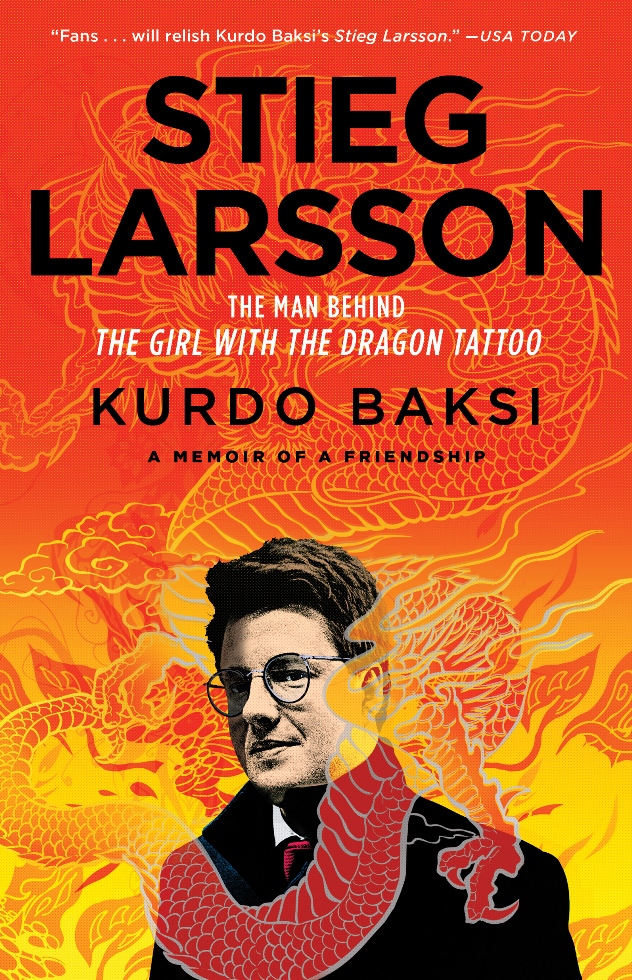“Stieg Larsson: The Man Behind The Girl With The Dragon Tattoo” by Kurdo Baksi is a portrait of the late Swedish crime novelist by a longtime friend and fellow crusading journalist. It serves as a tribute and a memoir that attempts to answer many questions about Larsson, the author who played with fire.
The Millennium trilogy books by Stieg Larrson have sold in excess of 80 million copies worldwide, making him the top selling Swedish author of all time and also one of the top selling authors of all time worldwide.
Just when Stieg Larsson was about to make his fortune with the mega-selling thriller The Girl with the Dragon Tattoo, the crusading journalist dropped dead from a heart attack after climbing the stairs to work on 9 November 2004. He was 50.
Because Larsson never wrote an official will, and because he never married his life partner Eva Gabrielsson, Larsson’s estate was awarded to his father and brother under Swedish laws. Eva, who lived with the author for 30 years, is locked in a protracted inheritance dispute with Larsson’s family, and claims that Larsson was estranged from his father and brother during the last years of his life. Reportedly, the couple never married because, under Swedish law, couples entering into marriage were required to make their addresses (at the time) publicly available, so marrying would have created a big security risk. Owing to Larsson’s reporting on extremist groups and the many death threats he had received, the couple had sought and been granted masking of their addresses, personal data, and identity numbers from public records, to make it harder for others to trace them; this kind of “identity cover” was integral to Larsson’s work as a journalist and would have been difficult to bypass if the two had married or become registered partners.
Kurdo Baski, the author, met Larsson in 1992 when Larsson was 38 and editor of the leftist magazine Expo and Baksi was 27, editor of another anti-racist magazine, Svartvitt. Larsson had just published his first book, “The Extreme Right,” on organized racism. From that meeting on, the two saw each other almost every day (in 1998 they merged the two magazines) until Larsson’s sudden death in 2004.
Larsson was a workaholic, an inveterate insomniac, an incorrigible chain smoker ( 2-3 packets a day) and a preternatural consumer of coffee (averaging about 20 cups a day), a campaigner for human rights, a crusader against the far-right and neo-Nazi groups, and an outspoken activist on violence against women . When Larsson was 15, he watched three friends rape a 15-year-old girl. Terrified, he did nothing to stop them and, haunted by her screams, went to apologize a few days later. She refused to accept his apology and told him she would never forgive him.
His life is dictated by a strict motto: Respect everybody, regardless of their skin colour, gender, language, religion, ethnic background or sexual orientation. Always. In all cicumstances. Unconditionally.
Larsson had seen the danger of xenophobic, racist and neo-Nazi groups becoming organised in Sweden and other Nordic countries. He worked non-stop to expose such groups. He helped raised funds for victims of racism. He tried to find homes for women who had fled sects or families where they had been living under duress. He worked intensively to arrange for residence permits for homosexuals from Muslim countries. He helped others to finish books when they got stuck and could not make progress. The concept of justice was an integral part of his being.
Baksi feels that Larsson has more in common with his character Lisbeth Salander than with Mikael Blomkvist. Larsson, like his character Mikael Blomkvist, was an investigative journalist, but the similarities end there. Larsson had a few similarities to Lisbeth Salander,not least their lack of confidence in so-called authorities. They both had a reluctance to talk about their pasts, preferring not to discuss their childhood. Moreover, they appear to have had similarly bad eating habits. Baksi believes that Salander is based in part on a young computer wizard and researcher with amazing internet hacking skills at Expo whose arrest for domestic abuse was much publicized.
Baksi is amazed by Larsson’s ability to write the Millennium novels in relative secrecy but he knows that Larsson, who was a voracious reader of crime fiction, got his inspiration from Elizabeth George, Erskine Childers, Norman Mailer, Arthur Conan Doyle, Agatha Christie, James Ellroy, John Buchan, John le Carre, Tom Clancy, Frederick Forsyth, Peter Hoeg, Mark Frost, Minette Walters, Patricia Cornwell, Liza Cody, Sue Grafton, Val McDermid, Dorothy Sayers and Sara Paretsky.
In 2003 Larsson brought the completed three Millennium books to the publisher Piratforlag which was partly owned by Liza Marklund, a successful crime writer who had shown active support for Larsson in the debate on the oppression of women in 2002. The publisher sat on them for a very long time before curtly refusing to publish the novels. That must have turned out to be the worst decision ever made by that publisher.
Larsson’s friend Robert Aschberg then recommended Larsson’s books to Norstedts, whose editors, having read the first two novels, promptly issued contracts for all the three books. The rest is history.
After reading this memoir, my respect for Larsson skyrocketed as he had left behind such a brilliant legacy. For fans of the Millennium trilogy, this book is a must-read.
 CY@CY Says Welcome to my dreamscape. Where a Lim is also a Ling.
CY@CY Says Welcome to my dreamscape. Where a Lim is also a Ling.
